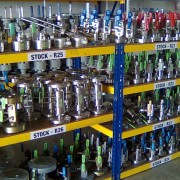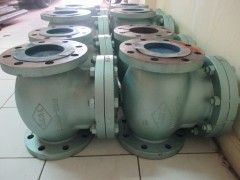Check valves
Check valves are "automatic" valves that open with forward flow and close with reverse flow. The pressure of the fluid passing through a system opens the valve, while any reversal of flow will close the valve. Exact operation will vary depending on the type of Check valve mechanism. Most common types of Check valves are swing, lift (piston and ball), butterfly, stop and tilting-disk.
Types of Check valves
|
Swing Check valve The disc in a swing type Check valve is unguided as it fully opens or closes. There are many disk and seat designs available, in order to meet the requirements of different applications. The valve allows full, unobstructed flow and automatically closes as pressure decreases. These valves are fully closed when flow reaches zero, in order to prevent backflow. Turbulence and pressure drop in the valve are very low. |
|
|
Lift Check valve Lift Check valves are particularly suitable for high-pressure service where velocity of flow is high. In lift Check valves, the disc is precisely guided and fits perfectly into the dashpot. Lift Check valves are suitable for installation in horizontal or vertical pipe-lines with upward flow. Flow to lift Check valves must always enter below the seat. As the flow enters, the piston or ball is raised within guides from the seat by the pressure of the upward flow. When the flow stops or reverses, the piston or ball is forced onto the seat of the valve by both the backflow and gravity. |
|
Images above are used with permission from Cameron International Corporation which retains all rights to that images






